Note: The following article contains moderate spoilers for Half-Life.

Over the past fortnight, I've beenrevisiting the original Half-Life, and its remake, Black Mesa, chewing over their weapons, setting, and place in FPS history. Now, I want to pick around the edges, to talk about the trivia. We're going to take some time out to explore the physics of Half-Life further.
The Anti-Mass Spectrometer
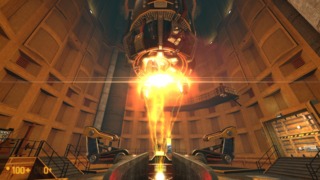
What better place to start than with Black Mesa's "anti-mass spectrometer"? This is the machine which, in analysing a sample of alien matter, starts a "resonance cascade" and connects Earth to the hostile cosmic outpost of Xen.[1] While "resonance cascades" are fictional, mass spectrometers are very much real. Isotopes are atoms with a particular number of neutrons in their nucleus. For example, if you find plutonium with 144 neutrons in its nucleus, that's the isotope plutonium-238. If you find plutonium with 145 neutrons, that's plutonium-239, a distinct isotope.[2]
Mass spectrometers can sort the atoms and molecules of matter based on their relative weight. The nuclei of all isotopes of an element have a unique weight. So, if you know the weights of the various isotopes out there, then look at the weights of the particles detected by your spectrometer, you can see where they line up to deduce what your sample matter is made of. This has made mass spectrometers standard kit in chemical analysis, and that includes chemicals from other worlds.[3] Our space agencies have used them to probe the Moon, Mars, and the gas giants, among other bodies, while Black Mesa tried to use one to get the lowdown on Xen. The beam that comes out of Black Mesa's anti-mass spectrometer is probably charging the particles in the Xen crystal, preparing them for analysis.[3]
The "anti-mass" part of the anti-mass spectrometer could indicate that the facility's machine analyses antimatter. For every particle of matter, there is a version of that particle that has all the same properties but with an opposite charge: this is its anti-particle. So, where an electron is negatively charged, an anti-electron or "positron" is positively charged. When matter and antimatter touch, their charges cancel out, and they annihilate. But antimatter doesn't tend to stick around for very long because of this volatile property.[4] That means that Gordon's stable crystal sample, which does not obliterate when in contact with a matter-based cart, cannot be antimatter.
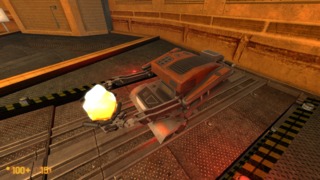
Perhaps Black Mesa's anti-mass spectrometer uses antimatter in its scans, even if it doesn't read antimatter. The "anti-mass spectrometer" could also be a spectrometer that analyses "anti-mass". We've never observed matter with negative mass, but that doesn't mean physicists haven't theorised about the concept. If you can imagine an object that weighs 20kg or 105kg, then you can imagine an object that weighs -20kg or -105kg. But like the sample Gordon places in the spectrometer probably isn't antimatter, it can't have negative mass either. When pushed forward, an object with negative mass would move in the opposite direction of the thrust, and we don't see that with the Xen crystal. Any item with negative mass would also fall through an item with positive mass, but Black Mesa's sample sits in its cradle quite comfortably.[5] So, similar to the conclusion we made with antimatter, maybe the anti-mass spectrometer employs negative mass in its inspection of matter.
Black Mesa's Weird Periodic Tables
If you cast your mind back to your school days, you'll remember that the periodic table lists elements by their atomic number. Look up the table today and direct your attention to the bottom right of the big castle, and you'll see the set of elements with the highest atomic numbers. There's element 112: copernicium (Cn), element 113: nihonium (Nh), and element 114: flerovium (Fl).[6] In Black Mesa's levels Anomalous Materials and Unforeseen Consequences, we can also find periodic tables, but on them, elements 112-118 aren't named the same as on our periodic table. Element 112 has the symbol Uub, element 113 is Uut, element 114 is Uuq, and on like this up to the end of the set. So, what gives?
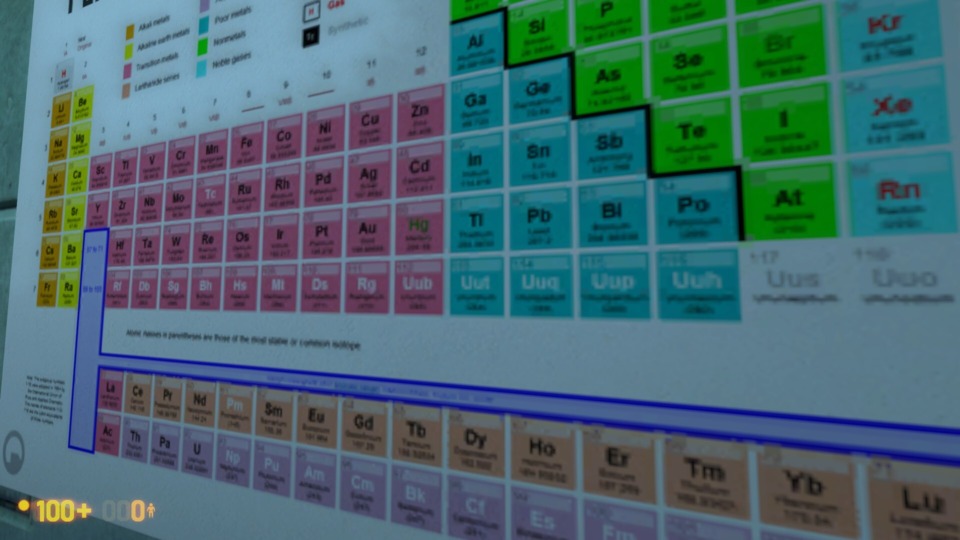
The atomic number of an atom tells us the quantity of protons in its nucleus. Hydrogen has 1 proton, so it has an atomic number of 1. Oganesson has 118 protons, so it has an atomic number of 118.[6] There might be limits to the number of protons you can have in an atom, but up to that possible maximum, you can always conceive of new elements because you can always add more protons.
Now, the element with the highest atomic number that's present in nature is uranium: number 92.[6] All elements with more protons than uranium have to be synthesised. But even once someone has forged a new building block of matter, it takes time for the scientific community to verify that and for the verified elements to get an official name from the IUPAC (the International Union for Pure and Applied Chemistry). In between the apparent discovery of new elements and their knighting by the IUPAC, placeholder names are included for them on the periodic table. Besides naming the chemicals, the IUPAC is also the organisation that came up with the scheme for assigning placeholder identities back in 1978.[7]
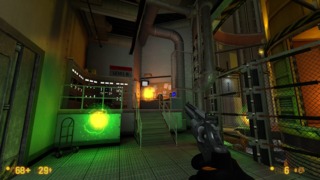
"Systematic element names" are cobbled together from references to the atomic number of the element, followed by the suffix "ium". In this scheme, the prefix "un" represents a 1, and "bi" represents a 2. So, in between the synthesising of element 112 and the confirmation of that discovery, it wore the name ununbium. "Tri" means three in this scheme, so the placeholder element 113 was ununtrium.[7] These elements are then given symbols made up of the first letters of their prefixes: Uub for ununbium, Uut for ununtrium, etc. Therefore, these are the names we see on Black Mesa's periodic table. So, the periodic table in Black Mesa's lab was printed after the naming of element 111 as roentgenium on November 1, 2004, but before the naming of any of the elements from 112 onwards. Ununbium, element 112, would be dubbed copernicium on February 19, 2010.
We can actually narrow down the game's dates even further using the wall hangings in the Black Mesa offices. All the calendars in the facility are flipped to the month of December and place December 1 on a Friday. In the 00s, there were only two years in which December 1 fell on that day: 2000 and 2006. Combine that with the date range from the periodic table, and we know that Black Mesa must take place during December 2006. If we steal a trick from Reddit user Neinfeld and use the phase of the Moon in On A Rail to pinpoint the time further, we can tell the game takes place about December 10.[8] Note that the base Half-Life may have a distinct timeline for which Neinfeld also has estimates.[8]
The Lambda Core Reactor
The waters around Black Mesa's all-important fission reactor glow blue, and that's not a fictional contrivance. The trope is that radioactive material glows green, and elsewhere in Half-life, it does. This concept was likely imprinted on the public by the radium-based luminescent paints used in the first half of the 20th century. It turns out, if you mix radium with a zinc sulfide/silver compound, it glows green, letting you create interfaces and signage that glow in the dark.[9] It also turns out, it can give you cancer. Uranium ore can also be green, and uranium glass glows green under UV light, although with most consumers not being miners or owning a blacklight, it's unlikely many of them would have been exposed to that knowledge.
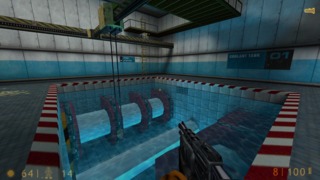
But reactors aren't covered in radioactive paint or made from radioactive glass. They do, however, spit out a lot of electrons, and those electrons emit photons. You'll be familiar with electrical particles emitting light quanta if you've ever seen a bolt of lightning. In media where you have electrons travelling faster than the photons they emit, you get this blue glow called "Cerenkov radiation". You might be thinking nothing can move faster than the speed of light, and that's kind of true, but when scientists say "speed of light", they generally mean the speed of light in a vacuum. When light passes through matter, like water, it slows down. With the light slowed, other particles, like electrons, can move faster than it, triggering the Cerenkov radiation.[10]
____
There are some other minor scientific morsels to be gleaned from Half-Life, like Valve naming Gordon Freeman after the physicist Freeman Dyson or the main menu giving a shoutout to the radioactive isotope Carbon-14, but we've hit the big points I wanted to.[11] While no one of the details we've discussed is a big part of the game, settings come to life in the confluence of little details, and it's in the details that Half-Life and Black Mesa live up to their laboratory theming. Thanks for reading.
Notes
- We know the sample analysed in the anti-mass spectrometer is from Xen: we can see crystals that look nearly identical in the outworld.
- Plutonium (August 25, 2023), World Nuclear Association.
- Mass Spectrometry by Paul Andersen (August 8, 2013), YouTube.
- Antimatter by Christine Sutton (February 27, 2024), Britannica.
- Landis, G.A. (2019). Negative Mass in Contemporary Physics and its Application to Propulsion. NASA Glenn Research Center.
- Periodic Table (Date Unknown), The Royal Society of Chemistry.
- International Union of Pure and Applied Chemistry (1978). Recommendations for the Naming of Elements of Atomic Numbers Greater than 100. De Gruyter.
- I have found the exact dates of every single major event in the Half-Life series. by Neinfeld (July 23, 2020), Reddit.
- Green glow of radiation by Karl S. Kruszelnicki (May 20, 2008), ABC Science.
- How does Cerenkov radiation work? by Fermilab (October 31, 2018), YouTube.
- Valve Corporation (2004). Half-Life 2: Raising the Bar. Prima Games (p. 30).
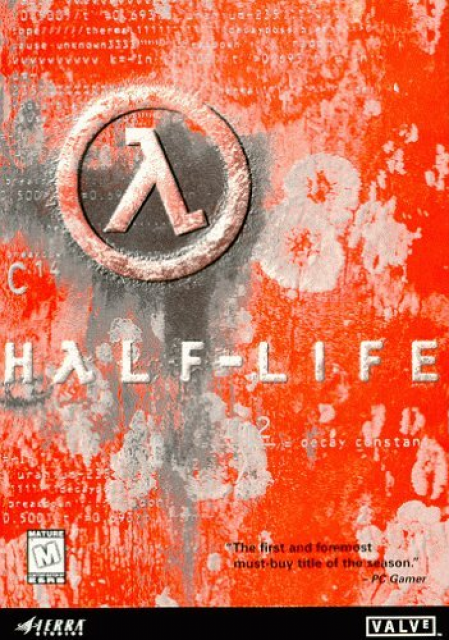
Log in to comment